GENERAL MENU
13 sharpest teeth in the animal kingdom
Let us say that another human bites you. It can certainly cause some severe damage to your skin and flesh. But never as the damage as the sharpest and strongest teeth on some animals can cause.
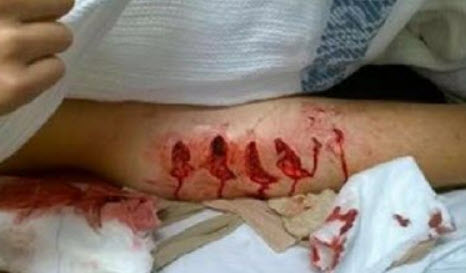
In some unfortunate cases, it can be lethal. The outcome of a shark bite Animals with the sharpest teeth can cause serious damage to your body.
In animal teeth, you will find nerves and vessels, sensations of hot and cold, etc. Animals can also get infections, and their teeth can break too!
Their teeth work like human teeth: they can bite and crush. But some big mammals can bite down with more strength. They can bite 30 times more potent than any human occlusion!
How is the strength of the occlusion measured?
PSI
PSI - Pounds Per Square Inch
The strength of the pressure of the occlusion (that means how hard you can bite and the power you can put down) is measured in pounds by square inch.
It means you measure the pressure from one object against another applied on a square inch.
The higher the PSI number is, the stronger the bite is. Let's look at the world's most dangerous bites in the animal kingdom.
What animal has the sharpest teeth?
13) GREAT WHITE SHARK - Carcharodon carcharias - 669 PSI

The great white shark lives in the coastal waters of most oceans. These are large animals that can measure as much as 20ft, and they can weigh up to 4,200 pounds.
They have no known predators except the orcas.
The Great white sharks have the most robust jaw of all shark species.
They are master predators with pointy, sharp big teeth.
The Great White has five rows of teeth where you can find as many as 3,000 dental pieces. These are rows of teeth formed behind the main ones.
They own a tooth reservoir. If a Great White loses a tooth, another will spin forward. They can grow their teeth again and may use up to twenty thousand in their lifetime.
The teeth set in the front are the largest and the ones that do most of the biting.
12) JAGUAR - Panthera Onca - 700 PSI

700 PSI, A Jaguar in the wild opening his jaw. Jaguar's teeth have a PSI of 700
The jaguar is a giant feline from the Panthera species. It is native to the Americas; it can live in the southern United States, Mexico, and Paraguay.
The jaguar resembles the leopard, but it is an enormous feline. They prefer to live in dense rainforests and swamps. It is a feline that enjoys swimming. The jaguar is a notable predator; they stalk and ambush their prey.
They have a mighty bite. They can even pierce and penetrate armored reptiles. Not only that, but they usually bite straight into the animal's skull after catching their prey. They cause fast and fatal cranial damage.
During the jaguar's hunt, they use their sharp teeth and jaws. They catch their prey by the head and chop them down to make the kill. They usually hunt on the ground but can climb to pounce on their game.
The jaguar's jaws have incredible strength. The jaguar's bite can be almost twice as strong as the African lion's.
11) SIBERIAN TIGER - Panthera Tigris Altaica 950 PSI
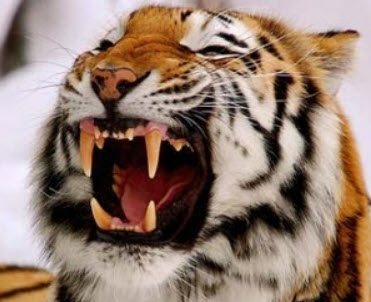
The Siberian Tiger has a PSI of 950
Siberian tigers live in a small area in the far east Russian mountain region. In the past, they also lived in northern China and Korea. Now they are a highly endangered species.
The Siberian tiger is the largest among the feline species on the planet. An adult male can weigh up to 700 pounds.
Like other subspecies of tigers, the Siberian tiger has fewer teeth than other mammal carnivores. They have a pair of long canines in the upper jaw. The canine teeth are more prominent (four inches long) than any other carnivore on the planet and will help kill their prey in just a single, quick bite.
10) SNAPPING TURTLE - Macrochelys Temminckii 1000 PSI
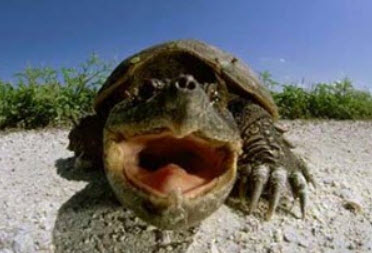
The snapping turtle is the heaviest turtle on the planet. Primarily found on the southeastern side of the U.S. waters.
They have no visible teeth but a sharp bite and a powerful jaw and neck.
Despite having no teeth, the substantial occlusion can easily amputate any human finger in a snap. They also have sharp edges on the mouth to rip any food apart.
Their carnassial teeth (teeth used to shear meat) are adapted for gripping and tearing flesh.
9) BENGAL TIGER - Panthera Tigris 1050 PSI
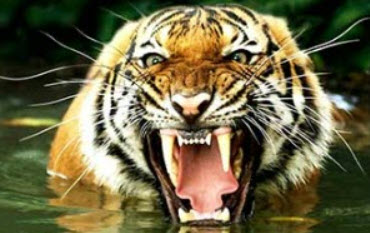
The Bengal Tiger is the largest species of tiger on the planet. There are only about 2,500 of them in the wild, with a decreasing trend.
The Bengal Tiger can weigh up to 500 pounds.
They are superb hunters; their prey includes monkeys, deer, hogs, etc.
Bengal Tigers have 30 teeth that they use to crush the bones and flesh of their prey.
Their most extended canines can measure up to 4 to 6 inches. All felines have temporary teeth that come a couple of weeks after being born. The Bengal Tiger's canine teeth are longer than the African Lion's.
8) HYENA - Hyaenidae 1100 PSI

Hyena's teeth have a PSI of 1100
Hyenas are feliform mammals, scavengers, and also predators.
They are skillful hunters; they hunt in packs. They resemble a cat and a dog at the same time. Furthermore, they make an unusual sound, like a laugh.
The hyena can weigh up to 180 pounds. It is the largest African carnivore after the African Lion.
They have sharp canines in the front, and crushing teeth, capable of grounding bones and flesh quickly. Their strong jaws with sharp and thick teeth can chew any bone.
Their strong teeth let them eat every piece of carcass. In the back of the mouth, they have carnassials that can ground complete massive mammal skeletons.
7) POLAR BEAR - Ursus Maritimus 1235 PSI

The polar bear lives in the Arctic Circle, surrounded by land masses and sea. Sister of the Brown Bear species, their body characteristics are adapted to the environment. It is on the endangered species list.
They have white hair, letting them hunt within the white environment of snow and ice. The Polar bear eats seals, fish, and salmon.
They are terrific swimmers, as they move almost all their life in cold water. They are classified as marine mammals, as they depend on the sea to obtain their primary food source.
The Polar bear has 42 teeth. They use their teeth for appearance as an aggressive facade and to catch their prey. They are bold and carnivorous.
Not only that, but they use their incisors to tear apart and smash flesh. They have sharper and longer teeth compared to the Brown bear.
6) GRIZZLY BEAR - Ursus Arctos Horribillis 1250 PSI
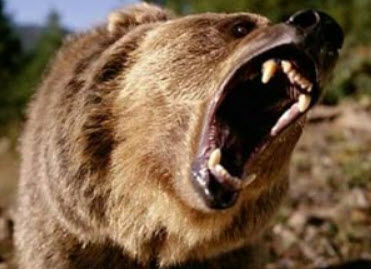
The Grizzly Bear has a PSI of, 1250 PSI.
The Grizzly Bear lives in North America and is the brown bear's largest subspecies.
The Grizzly Bear is a predator. It is the largest land mammal on the planet. Males can measure up to 40% larger than females and reach a weight of up to 400 pounds. They are fast too! Grizzlies can reach speeds of 35 mph on the run. They are fantastic swimmers as well.
The Grizzly bear owns 42 teeth. The teeth are located in the front of the mouth and are long and sharp to tear their prey. They are omnivores; they own molars on the back-to-ground roots and weeds. The cubs grow their adult teeth 18 months after birth.
5) GORILLA - Gorilla 1,300 PSI

Gorilla's teeth have a PSI of 1,300
Gorillas are herbivorous apes that dwell in the forests of Central Africa. All gorilla species are critically endangered.
They are the most prominent members of the primates. They are the closest relatives to humans, as they share 99% of our DNA.
Gorilla's teeth are sharp. Even though they do not eat flesh, they need to ground complex roots and weeds.
The canines on the front look long and sharp, but their purpose is to display anger and show a threat to their enemy.
4) HIPPOPOTAMUS - Hippopotamus Amphibius 1,820 PSI

The Hippopotamus teeth have a PSI of 1820
The hippopotamus is a large herbivorous mammal that lives in Africa. The hippo is also the third-largest type of land mammal; it can weigh up to 3,300 pounds.
It is known as an unpredictable and extremely dangerous mammal. The Hippo's reputation places them among the most dangerous animals in Africa.
The Hippo's teeth grind, and they sharpen themselves. On the lower jaw, the incisors and canines are enlarged and continuously growing; they can reach up to 50 cm. They use them for combat.
Hippos grasp the grass and pull them back to the molars, where they can chew.
3) NILE CROCODILE - Crocodylus Niloticus 5,000 PSI
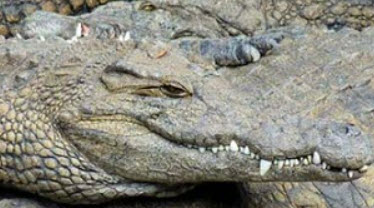
The Nile crocodile is the second largest reptile after the Saltwater Crocodile.
They are widespread in Southern, eastern, and central Africa.
The adult male can be as long as 17 ft and weigh over 1,600 pounds.
The Nile crocodile has an extremely dangerous bite. Their teeth can grasp the prey with a powerful force for long periods. Usually, they hold the victim underwater until they drown it to eat it.
The jaws of Nile crocodiles have over 60 sharp teeth, all cone-shaped. The 4th tooth on the lower mandibles is visible when the mouth is closed.
2) SALTWATER CROCODILE - Crocodylus Porosus 7,700 PSI
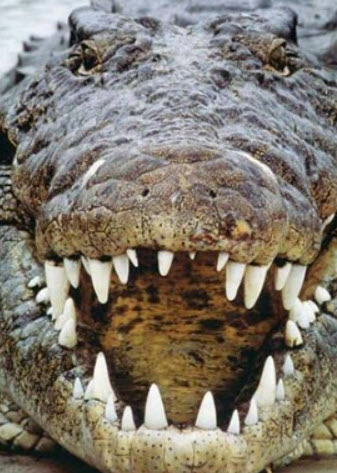
The teeth of the Saltwater Crocodile The Saltwater Crocodile has a PSI of 7,700
The Saltwater Crocodile is the largest of all the reptilian families. He can be up to 23 feet long and weigh up to 1,300 kilograms (about 2,600 lb).
The Saltwater Crocodile is a predator. They usually swallow their whole prey. They eat whatever they can take; it is capable of eating whatever enters their territory, including humans.
The Saltwater Crocodile has the most oversized fangs. Each tooth can measure up to 4 inches.
They grasp their prey and turn them around with their 450-pound body weight. The sharp bite gets support from the tendons and muscles at the base of the animal's skull.
1) ORCA - Orcinus Orca 19,000 PSI

The Orca's teeth have a PSI of 19,000
The Orca or Killer Whale is the largest member of the dolphin species family and has the sharpest teeth of all animals.
Orcas are predators; they are at the top of the food chain in marine life. No other animal preys on orcas; they can even hunt seals, sharks, and dolphins.
The Orca's big jaws apply a mighty grip. Their teeth are super sharp. When the mouth is closed, the upper teeth fall into the gaps between the lower teeth when the mouth closes.
What is the potential danger of animal bites for humans?
- There are animal bites that can cause deep lacerations, tissue damage, or even the loss of limbs.
- Animal bites have the potential to introduce bacteria from the animal's mouth into the human body, resulting in infections such as tetanus, and rabies, or bacterial infections such as Pasteurella multocida, which is commonly associated with cat bites.
- Some animals like snakes, spiders, scorpions, bees, and wasps have venomous bites. These bites can put poisonous substances into the victim's body, which could cause serious reactions or even death if not treated quickly.
- Some parts of the body, such as the face, neck, or joints, maybe more dangerous due to the risk of damage to critical structures, such as blood vessels, nerves, or joints.
- Some people may be allergic to parts of certain animals' saliva or venom, which can cause allergic reactions that range from mild itching or swelling to severe anaphylaxis.
- Animal bites can cause serious problems like tissue damage, sepsis, or long-lasting pain if they aren't treated or taken care of properly.
- Rabies can be spread through animal bites, especially from animals like dogs, bats, raccoons, or foxes. Rabies is a fatal viral infection of the central nervous system that demands immediate medical care and post-exposure prevention to avoid the onset of symptoms.
